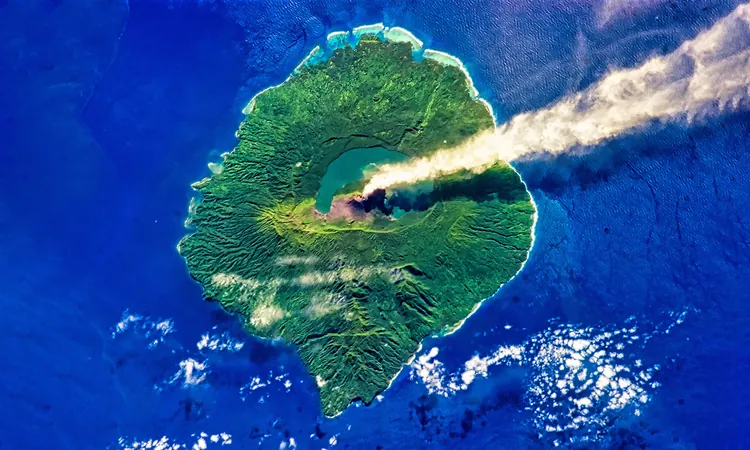
Groundbreaking Discovery: Can Plants Predict Volcanic Eruptions?
2025-01-04
Author: Chun
Volcanoes possess immense power, often lying dormant while brewing turmoil beneath the Earth's surface. As traditional monitoring techniques like seismic activity assessment and gas sampling can overlook subtle signals, researchers are exploring a unique approach—utilizing the behavior of plant life to predict eruptions.
The Hidden Connection Between Plants and Volcanic Activity
Volcanic gases, particularly carbon dioxide, are frequently released when magma ascends. Yet, detecting these gases poses challenges since they also emanate from numerous natural and human activities. Given that certain remote volcanoes lack permanent monitoring systems, scientists are looking toward nature for indicators of impending eruptions.
One notable study spearheaded by Robert Bogue at McGill University focused on the vegetation health in the hydrothermal zones of Yellowstone Caldera. The research revealed that plants exhibit changes in their growth patterns in response to subterranean shifts, suggesting they could signal an eruption's approach.
How Do Plants Respond?
Plants are highly adaptive and can alter their growth in reaction to environmental changes, including variations in carbon dioxide levels, sulfur compounds, and soil temperatures—all of which can be influenced by volcanic activity. Notably, early signs of volcanic unrest might manifest in the health and functioning of surrounding flora months or even years before an eruption occurs.
Field observations can be challenging, as identifying minuscule changes in vast forests requires advanced techniques. Thus, satellite imaging has become an indispensable tool, enabling researchers to identify subtle stress signals or unusual growth patterns across extensive areas.
Utilizing Technology to See the Changes
A pivotal technique in this research is the Normalized Difference Vegetation Index (NDVI), which assesses plants' photosynthetic vigor based on chlorophyll content. This index provides a numerical score that helps track vegetation health over time, offering clues to what might be happening underground.
Research indicates that minor emissions of carbon dioxide and heated fluids can initially enhance local plant health, but exposure to excess harmful gases or extreme temperature fluctuations can lead to plant stress and death.
One prime example is Wyoming's Tern Lake in the Yellowstone Caldera. Satellite imagery studied over decades showed a notable increase in tree health for 16 years, possibly due to enriched soil. However, by the early 2000s, significant declines became evident, signifying the onset of stress as soil temperatures surged and toxic gas emissions increased.
Unveiling the Mystery Below the Surface
The correlation between vegetation changes and hydrothermal fluid movement toward the surface became apparent in Bogue's investigation. Earthquake data supported observations that swarms of small tremors might indicate magma or heated fluids navigating new escape routes.
The research captures an evolving story of volcanic activity long before traditional surveys might detect it. Interestingly, some recent observations also reveal new seedlings emerging in areas once ravaged by volcanic stress, suggesting a tentative recovery in the ecosystem, at least temporarily.
The Significance of These Findings
These findings showcase that forests can act as valuable indicators of subterranean volcanic processes. While scientists have traditionally relied on thermal cameras and gas detectors, these measures face limitations in harsh terrain. Satellite imagery offers a broad perspective, allowing researchers to monitor remote regions more effectively.
Vegetation-based monitoring does not replace existing methods but provides an additional layer of insight. Unusual trends in plant health can trigger closer investigations and data collection, potentially allowing for earlier warnings of volcanic activity.
Towards a Safer Future
Each volcano presents unique challenges, with varying surrounding terrains that influence plant presence. In regions where vegetation thrives, scientists aim to leverage this information alongside other monitoring indicators—like earthquakes, ground swelling, and gas composition changes—to develop a more comprehensive understanding of volcanic threats.
Through continued refinement of these strategies, the hope is to direct efforts toward volcanoes that present the highest risk of eruptions. The Tern Lake study illustrates the potential of natural systems to act as early warning devices, paving the way for timely alerts and ultimately, enhancing public safety during volcanic events.
The full study is documented in the journal *Geochemistry, Geophysics, Geosystems*, promising to reshape our understanding of how nature may guide us toward predicting catastrophic eruptions with greater accuracy than ever before.


 Brasil (PT)
Brasil (PT)
 Canada (EN)
Canada (EN)
 Chile (ES)
Chile (ES)
 Česko (CS)
Česko (CS)
 대한민국 (KO)
대한민국 (KO)
 España (ES)
España (ES)
 France (FR)
France (FR)
 Hong Kong (EN)
Hong Kong (EN)
 Italia (IT)
Italia (IT)
 日本 (JA)
日本 (JA)
 Magyarország (HU)
Magyarország (HU)
 Norge (NO)
Norge (NO)
 Polska (PL)
Polska (PL)
 Schweiz (DE)
Schweiz (DE)
 Singapore (EN)
Singapore (EN)
 Sverige (SV)
Sverige (SV)
 Suomi (FI)
Suomi (FI)
 Türkiye (TR)
Türkiye (TR)
 الإمارات العربية المتحدة (AR)
الإمارات العربية المتحدة (AR)